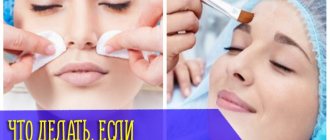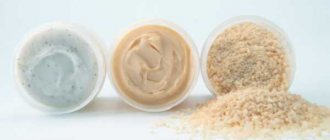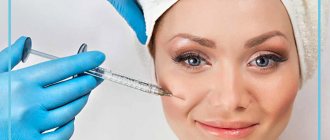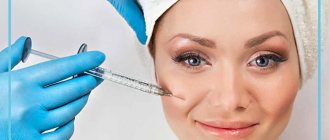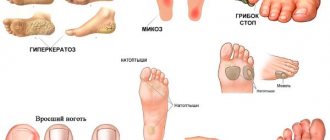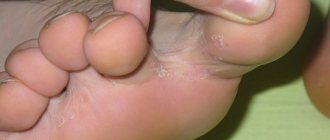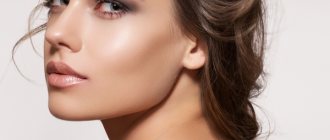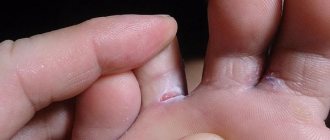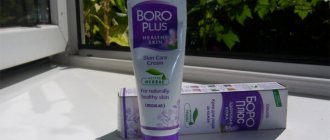- What is laser skin rejuvenation without surgery?
- Indications: fractional laser rejuvenation
- Unique features of laser facial rejuvenation
- What problems does the MCL-30 DermablateEr:Yag 2940 laser solve?
- Contraindications for laser skin rejuvenation
- How does a therapy session work?
- Photo: before and after
- Fractional thermolysis video
- Final result
- Prices
With age, collagen fibers are poorly produced, as a result of which the skin sags and the oval of the face becomes unclear, a double chin becomes visible, and the corners of the eyes and lips droop.
When people are young, there is enough collagen in their skin, so facial tissues successfully resist changes. You can only get rid of drooping chin, cheeks and eyelids with the help of a plastic surgeon. Therefore, it is better to think about this problem in advance and use laser skin rejuvenation when signs of age-related changes appear. Fractional rejuvenation is the most suitable option for most clients because it produces the desired results without the need for surgery.
What is laser rejuvenation (fractional photothermolysis)?
Laser rejuvenation is one of the most serious cosmetic methods aimed at completely eliminating wrinkles and sagging areas.
The impact on the dermis is carried out using a beam of an energy generator, the doctor determines its optimal temperature and depth, after which the treatment of the epidermis begins. Due to the high temperature, skin cells burn, thereby provoking the body to completely renew the skin.
Fractional thermolysis (ablation) is a method of laser resurfacing of the face and body under the influence of high temperatures. In other words, during exposure, the thinnest laser beam removes and helps cope with age-related changes in the skin by removing micro-portions of old skin with the formation of micro-thermal zones on it. At this moment, the effect of laser skin rejuvenation occurs. The recovery process begins, accompanied by increased synthesis of collagen and elastin, leading to renewal of the skin throughout its depth. Collagen is the reinforcing protein of our skin, which creates its frame. The laser rejuvenation procedure is carried out at the Absolut Med clinic using an erbium laser MCL-30 Dermablate manufactured (Germany).
Today, rejuvenation of the skin of the face and body using fractional photothermolysis makes it possible to obtain amazing results. The rejuvenation effect is safe and allows its use even in those patients who have contraindications to plastic surgery. The result lasts for a long time.
Restrictions
Since FF is a new technique, our results should be considered preliminary. The long-term side effects and benefits of the procedure need to be clarified. To confirm our results, it is necessary to conduct a series of long-term studies on a larger number of patients with various forms of skin diseases. The parameters of the FF procedure must be constantly refined to improve the final result and minimize patient discomfort and costs. According to the author, there is still no information on the effect of FF on erythema and telangiectasia.
Indications for fractional rejuvenation
- Reduction of depth and complete correction of wrinkles;
- Reduction of pore sizes;
- Correction of gravitational ptosis;
- Restoring skin elasticity;
- Removal of pigment spots;
- The need to remove traces of post-acne, scar changes and stretch marks;
- Getting rid of hyper- and atrophic, postoperative and post-traumatic scars;
- Improvements in skin structure and color.
Unique advantages of laser rejuvenation:
- With each procedure, 15-25% of old tissue can be removed, and healthy young skin is formed in its place.
- Remodeling processes occur in depth, and not just on the surface. The collagen and elastin framework is renewed.
- Solving several cosmetic problems simultaneously in one session.
- There are no restrictions on skin color, thickness or sensitivity. The procedure is suitable for all skin types.
- Laser rejuvenation can be used on any delicate areas, for example, the hands, décolleté, neck, eyelids, etc.
- No special medical care is required other than standard SPF sun protection and moisturizing cosmetics. The convenient fact is that makeup can be applied the next day after the procedure.
- The procedure is performed using only local anesthesia and lasts 30-60 minutes.
Carrying out the procedure
2 weeks before the session you need to stop using scrubs and peels, as they damage the skin. External products containing salicylic acid, retinol, and glycolic acid are also discontinued.
Progress of the procedure:
- Cleansing the skin, applying local anesthesia.
- Applying ointment to the skin, which facilitates the sliding of the device nozzle.
- Treatment of the required area with a special nozzle. The client does not feel pain because anesthesia is in effect and a stream of cold air is directed onto the skin. The time of one session is usually 30-40 minutes. At the treatment site, an area of skin with an area of 0.5-2 cm2 is exposed.
- After the procedure, a cream is applied to the skin, which has a soothing effect and reduces swelling and redness.
How does the session work?
During the consultation, the cosmetologist first determines the goals for which the client came, finds out possible contraindications to the procedure, and talks about the possible results. The method of numbing the treated area is also discussed.
- Preparing the client's skin for the upcoming laser rejuvenation procedure. To do this, the area of skin that will be affected is cleansed. Then a special anesthetic cream is applied to reduce pain.
Sequential fractional laser treatment. Takes about 30 minutes. During the session, the cosmetologist moves a nozzle over the surface, which emits a targeted laser beam. If necessary, the same area (depending on the problem) is treated multiple times within one procedure. The procedure can last from 30 minutes to 1 hour. It all depends on the volume of leather being processed.- Applying a special cream or ointment. Upon completion of fractional photothermolysis, a cream with a soothing effect is applied to the “polished” surface.
To achieve the desired result, it is necessary to carry out a course of several procedures - from 3 to 5. The number of procedures and type of impact are determined by a cosmetologist during an in-person appointment. A session can be performed once every 6 months.
Biological and clinical effects of FF
To evaluate the biological and clinical effects associated with FF, Manstein et al [15] treated the forearms and periorbital areas using a prototype laser-based fractional device (Reliant MTZ™ SR, Reliant Technologies, Palo Alto, CA).
Biological effects
To test the effect obtained at different densities of MLZ (400, 1600 and 6400 MLZ/cm2) on the skin, the forearms of 15 healthy people (skin types II–VI) were treated once with a FF device with a pulse energy of 5 mJ without the aid of anesthesia or cooling. A delay of 50 milliseconds between pulses prevented the heat from spreading. Histological examination of tissue damage was carried out three months after treatment.
Typical MLZs penetrated to a depth of 300 µm and had a diameter of 100 µm (Fig. 1). Epithelial restoration was completed one day after treatment. Recovery was accompanied by the displacement of destroyed components of the epidermis—microepidermal necrotic debris (MENDS)—at the boundaries of the MLZ. MENDS are button-shaped structures (40–80 μm in diameter) that contain melanin and form beneath the intact stratum corneum over each dermal wound. The appearance of MENDS indicates the transition of keratinocytes to an active state, in which they participate in tissue repair. During the formation of MENDS, the treated areas acquired a light bronze tint, which remained for several weeks after laser treatment.
Histological studies also showed increased mucin deposition and the presence of an in-depth network of projections on the surface of the dermis. A study of the forearms showed that MLZ densities of 1600/cm2 or less were well accepted by the skin and that the side effects associated with ablative laser resurfacing did not occur in the treated areas.
Clinical effects
Lateral periorbital wrinkles in 30 subjects were treated four times using an FF device equipped with a portable scanner. Most participants received local anesthesia. The operator moved the scanner over the skin to obtain a specific laser pattern with the selected MLZ location density. The scanner tracked the speed of the hand movement, so the exposure time was less than 5 milliseconds to minimize blurring of the MLZ contours. Each pulse created one MLZ and had a duration from 1.5 to 5 milliseconds.
Figure 1. Histological section of human skin after treatment with FF (15 mJ) shows two microthermal zones with a depth of 560 µm and a width of 135 µm.
In this study, the amount of energy and wavelength were varied, but the overall density of the MLZ was kept constant. Each treatment consisted of 10 passes, 5 in one direction, and 5 in a perpendicular direction. The rate of MLZ creation was 120 s-1, and the average total flux density per pass ranged from 1.6 to 3 J/cm2. The condition of the participants' skin was subsequently assessed for the smoothing of wrinkles, skin tightening, the presence of soreness and other undesirable effects.
Both mild and moderate improvements were observed in wrinkle improvement and skin texture one and three months after the last treatment, as rated by patients and investigators. After randomizing the photographs, the dermatology researchers selected postoperative photographs as “higher quality” 96% of the total patient photographs. Three months after the last treatment, the wrinkles assessed by the Fitzpatrick scale were significantly smaller compared to those present before treatment.
As for the linear contraction of the skin, it should be noted that it was significant during the first week, followed by relaxation after one month, and three months after the last treatment, re-compression of the skin by 2.1% was detected.
The level of pain during the procedure changed with each subsequent pass and decreased to zero 10-60 minutes after the procedure. The pain increased with subsequent passes but resolved within a short period of time after treatment. The level of pain depended on the laser energy and did not change with subsequent procedures. Swelling after the procedure decreased within 24 hours in 90% of patients. Erythema appeared within one day, decreased rapidly within the first week, and virtually disappeared after one month. No pigment changes were noticed.
The authors conclude that: (1) the prototype FF device showed encouraging results; (2) side effects were less severe compared to ablative and non-ablative laser treatments; (3) further research will make it possible to more accurately determine the optimal parameters for the treatment of skin pathologies. The Fraxel® laser (Reliant Technologies, Palo Alto, CA) has been approved by the FDA for the treatment of pigmentary disorders, periorbital wrinkles, melasma (melasma), dermatologic procedures including soft tissue coagulation, and skin resurfacing.
Before and After Photos of Fractional Laser Rejuvenation
Where to get fractional laser rejuvenation in Moscow
Contact the aesthetic medicine clinic in Moscow “Absolut Med” near the Airport metro station in the Northern Administrative District, which uses innovative technology - the MCL-30 Dermablate erbium laser. This laser can be considered a revolution in aesthetic cosmetology.
| Name | Price for 1 procedure |
| Fractional photothermolysis - face | 23 000 ₽ |
| - face, neck | 27 000 ₽ |
| - face, neck, décolleté | 30 000 ₽ |
| - buccal area | 10 000 ₽ |
| - neck | 10 000 ₽ |
| - neckline | 10 000 ₽ |
| - upper eyelids | 4 000 ₽ |
| - lower eyelids | 4 000 ₽ |
| - paraorbital region | 7 000 ₽ |
| - perioral region | 5 000 ₽ |
| - chin area | 7 000 ₽ |
| - nasolabial triangle | 5 000 ₽ |
| - nose | 3 000 ₽ |
| - forehead | 8 500 ₽ |
| Fractional photothermolysis-body | |
| - Hands | 7 000 ₽ |
| - stomach (1 zone) | 7 000 ₽ |
| — back (1 zone) | 7 000 ₽ |
| - lateral thigh | 7 000 ₽ |
| - back of the thigh | 7 000 ₽ |
| - inner thigh | 7 000 ₽ |
| - anterior thigh | 7 000 ₽ |
| - one full thigh | 12 000 ₽ |
| - shoulders | 7 000 ₽ |
| - shins | 7 000 ₽ |
| - mammary gland | 12 000 ₽ |
| - buttocks | 12 000 ₽ |
| - forehead | 8 500 ₽ |
| Fractional photothermolysis (per 1 sq.cm) | 800 ₽ |
| Laser facial resurfacing | 30 000 ₽ |
| Laser resurfacing of the eye area | 9 000 ₽ |
